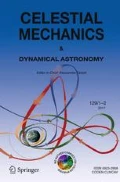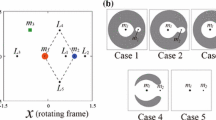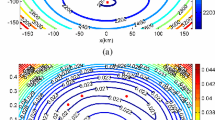Abstract
We consider dynamics of a Sun–Jupiter–Asteroid system, and, under some simplifying assumptions, show the existence of instabilities in the motions of an asteroid. In particular, we show that an asteroid whose initial orbit is far from the orbit of Mars can be gradually perturbed into one that crosses Mars’ orbit. Properly formulated, the motion of the asteroid can be described as a Hamiltonian system with two degrees of freedom, with the dynamics restricted to a “large” open region of the phase space reduced to an exact area preserving map. Instabilities arise in regions where the map has no invariant curves. The method of MacKay and Percival is used to explicitly rule out the existence of these curves, and results of Mather abstractly guarantee the existence of diffusing orbits. We emphasize that finding such diffusing orbits numerically is quite difficult, and is outside the scope of this paper.






Similar content being viewed by others
Notes
To be precise, the perihelion is the point where the asteroid is at the closest point to the center of mass of the system, and the Sun is within \(\mu \) of the center of mass. However, in our Solar System, the radius of the Sun is approximately \(0.00089\) the Sun–Jupiter distance, so we allow this slight abuse in terminology for small \(\mu \).
For \(J_0\) near or less than \(1.52\) collisions with Jupiter are hard to exclude.
Notice that the angle \(\varphi \) enters into the perturbation \(\varDelta H\) (see (2)). As the Poincaré map \(\mathcal{F }_\mu \) is defined for approximately one revolution of the asteroid, then the change in the \(\varphi \) component should average out for higher order terms in the \(\mu \) expansion of \(\varDelta H\).
More precisely, it follows from the geometry of ellipses that \(e=\sqrt{1-\frac{G^2}{L^2}}\) in Delauney coordinates; a quick conversion to polar coordinates yields the formula \(e= \sqrt{1 - 2 J_0 P_{\varphi }^2 + 2 P_{\varphi }^3}\).
This construction actually localizes all Aubry–Mather sets with rotation symbol \(\omega \in \left[\frac{1}{n+1}+,\frac{1}{n}-\right]\). See Sect. 6 for definitions.
From hereon out, results may be stated using the \((\varphi ,P_\varphi )\) parameterization of annulus, as opposed to \((\varphi ,e)\). The former parameterization is easier to work with numerically; the later is better for intuition.
For \(v=(a,b)\), let \(\bar{v}=(1,\frac{b}{a})\) be a normalization of \(v\). A vector \(v_1\) lays above \(v_2\) iff \(x \ge y\), where \(\bar{v}_1=(1,x)\) and \(\bar{v}_2=(1,y)\).
For an introduction to interval arithmetic, refer to the paper by Wilczak and Zgliczynski (2007).
References
Arnol’d, V., Kozlov, V., Neishtadt, A.: I.: Mathematical aspects of classical and celestial mechanics. Dynamical systems. III. Translated from the Russian original by E. Khukhro. Third edition. Encyclopaedia of Mathematical Sciences, 3. Springer, Berlin (2006)
Bangert, V.: Mather sets for twist maps and geodesics on tori. Dynamics reported, vol. 1, 1–56, Dynam. Report. Ser. Dynam. Systems Appl., 1, Wiley, Chichester (1988)
Bernard, P.: The dynamics of pseudographs in convex Hamiltonian systems. J. Am. Math. Soc. 21(3), 615–669 (2008)
Bourgain, J., Kaloshin, V.: On diffusion in high-dimensional Hamiltonian systems. J. Funct. Anal. 229(1), 1–61 (2005)
Broucke, R., Petrovsky, T.: Area-preserving mappings and deterministic chaos for nearly parabolic motions. Celest. Mech. 42(1–4), 53–79 (1987)
Curtis, H.: Orbital Mechanics for Engineering Students, 2nd edn. Butterworth-Heinnemann, Amsterdam (2010)
Celletti, A., Chierchia, L.: KAM stability and celestial mechanics. Mem. Am. Math. Soc. 187(878), viii+134 (2007)
Chenciner, A., Llibre, J.: A note on the existence of invariant punctured tori in the planar circular restricted three-body problem. Ergod. Theor. Dyn. 8, 63–72 (1988)
Fejoz, J.: Quasiperiodic motions in the planar three-body problem. J. Differ. Equ. 183(2), 303–341 (2002)
Fejoz, J., Guardia, M., Kaloshin, V., Roldan, P.: Diffusion along mean motion resonance in the restricted planar three-body problem. arXiv:1109.2892v1 (2011)
Ferraz-Mello, S.: Slow and fast diffusion in asteroid-belt resonances: a review. Celest. Mech. Dyn. Astron. 73, 25 (1999)
Gole, C..: Symplectic twist maps. Global variational techniques. Advanced series in nonlinear dynamics, 18. World Scientific Publishing Co., Inc., River Edge, xviii+305 pp. (2001) ISBN: 981-02-0589-9
Galante, J., Kaloshin, V.: Destruction of invariant curves in the restricted circular planar three body problem using comparison of action. Duke Math. J. 159(2), 275–327 (2011)
Galante, J., Kaloshin, V.: Construction of a twisting coordinate system for the restricted circular planar three body problem. Manuscript. Available at http://www.terpconnect.umd.edu/vkaloshi/papers/Twist-spreading-Joseph.pdf
Galante, J., Kaloshin, V.: Destruction of invariant curves in the restricted circular planar three body problem using ordering condition. Manuscript. Avaliable at http://www.terpconnect.umd.edu/vkaloshi/papers/localization-joseph.pdf
Goldstein, H., Poole, C., Safko, J.: Classical Mechanics, 3rd edn. Addison Wesley, San Francisco (2001)
Kaloshin, V.: Geometric Proof of Mather’s Connecting Theorem. Preprint. Available Online. http://www.its.caltech.edu/kaloshin/research/mather.pdf
Liao, X., Saari, D.G.: Instability and diffusion in the elliptic restricted three-body problem. Celest. Mech. Dyn. Astron. 70(1), 23–39 (1998)
MacKay, R., Percival, I.: Converse KAM. Comm. Math. Phys. 98(4), 469–512 (1985)
Mather, J.: Variational construction of orbits of twist diffeomorphisms. J. Am. Math. Soc. 4(2), 207–263 (1991)
Mather, J.: Differentiability of the minimal average action as a function of the rotation number. Bol. Soc. Brasil. Mat. 21, 59–70 (1990)
Mather, J., Forni, G.: Action minimizing orbits in Hamiltonian systems. Transition to chaos in classical and quantum mechanics (Montecatini Terme, 1991), 92–186, Lecture Notes in Math., 1589, Springer, Berlin (1994)
Moser, J.: Recent development in the theory of Hamiltonian systems. SIAM Rev. 28(4), 459–485 (1986)
Moser, J.: Stable and random motions in dynamical systems. With special emphasis on celestial mechanics. Reprint of the 1973 original. With a foreword by Philip J. Holmes. Princeton Landmarks in Mathematics. Princeton University Press, Princeton, NJ (2001)
Rogel, J.V.: Early aubry-mather theory. Informal talks delivered at the Summer colloquium of the computational science department at the National University of Singapore (2001)
Siburg, K.F.: The principle of least action in geometry and dynamics. Lecture Notes in Mathematics, Springer-Verlag, Berlin, xii+128 pp. (2004) ISBN: 3-540-21944-7
Siegel, C., Moser, J.: Lectures on celestial mechanics. Translation by Charles I. Kalme. Die Grundlehren der mathematischen Wissenschaften, Band 187. Springer-Verlag, New York (1971)
Wisdom, J.: The origin of the Kirkwood gaps. Astron. J. 87, 577–593 (1982)
Wisdom, J.: Chaotic behavior and the origin of the 3/1 Kirkwood gap. Icarus 56, 51–74 (1983)
Wisdom, J.: A pertubative treatment of motion near the 3/1 commensurability. Icarus 63, 272–289 (1985)
Wilczak, D., Zgliczynski, P.: The \(C^r\) Lohner-algorithm. arXiv:0704.0720v1 (2007)
Xia, J.: Arnold Diffusion and Instabilities in Hamiltonian Systems. Preprint. Available Online. http://www.math.northwestern.edu/xia/preprint/arndiff.ps
Acknowledgments
The authors would like to acknowledge the guidance and direction given by Vadim Kaloshin. Without his input this paper certainly would not have been possible. The authors would also like to thank Anatoly Neishtadt for his remarks.
Author information
Authors and Affiliations
Corresponding author
Rights and permissions
About this article
Cite this article
Urschel, J.C., Galante, J.R. Instabilities in the Sun–Jupiter–Asteroid three body problem. Celest Mech Dyn Astr 115, 233–259 (2013). https://doi.org/10.1007/s10569-012-9461-8
Received:
Revised:
Accepted:
Published:
Issue Date:
DOI: https://doi.org/10.1007/s10569-012-9461-8




